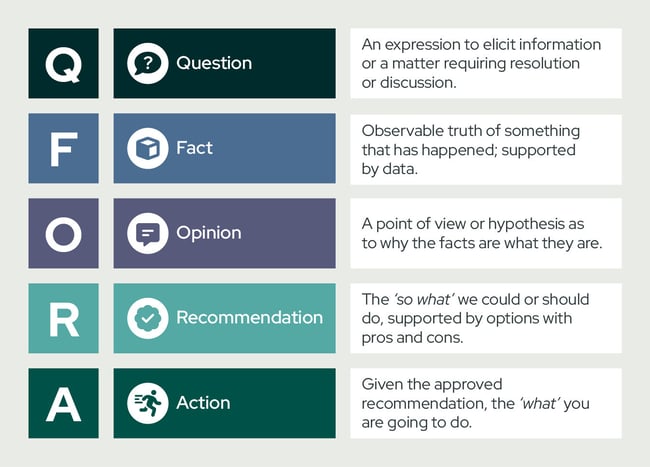
How to ask great questions that result in Action: QFOR-A (Question, Fact, Opinion, Recommendation, Action)
QFOR-A is one of our most-used frameworks. It stands for Question, Fact, Opinion, Recommendation and Action. The hyphen between the R and the A reminds us that the point of asking any question should be to seek recommendations for action. All facts, opinions and recommendations given to answer questions should also drive action.
We advocate using our QFOR-A discipline in various contexts: board pack writing, boardroom discussion and to help transform raw data into answers that lead to business improvement. It can help to maintain focus, structure thinking and writing and keep meetings on track.

Asking questions in the boardroom
We ask questions to learn. We might ask them to understand why something is true or to get information about a matter that needs resolution or discussion.
Or that’s why we should ask them, at least in a business context.
Too often, people ask questions for the wrong reasons. While good questions are driven by a genuine intent to learn, people can ask questions to demonstrate how much they know or to catch someone out.
Loaded and leading questions have no place in the boardroom. Loaded questions are asked to implicate the respondent in some way while leading questions are designed to steer the respondent down a particular path. They are not driven by a desire to improve.
Good questions take various forms. For example, closed, quick questions can be used to ascertain facts, ‘Did you meet the target?’ or predictions ‘When will the testing be finished’? Open questions can be used to understand more – perhaps the root cause of why something has happened or to understand thoughts, feelings or beliefs.
The best way to get an opinion is often to ask an open ‘why’ question, one that begins ‘Why do you think...’. ‘Why do you think we are so off target’, or ‘Why do you think we should open an office in New York?’
Answering questions in the boardroom
A question can be answered with one of three statements – a fact, opinion or recommendation. Ideally, the three should work together.
Facts are observable truths often supported by data: ‘Where are we against budget?’ ‘What’s the gap between the target and actual?’ etc.
Facts alone are not enough to formulate recommendations. They are overlaid with opinions (or perspectives) about why the facts are what they are.
Recommendations are a type of opinion. Recommendations tell us what someone believes should be done. They are the ‘So what?’. What does the insight mean? What conclusions (and therefore recommendations) can you draw from it? In board meetings, Chairs direct discussions to reach recommendations that lead to action.
Confusion creeps in when opinion is presented as fact. We often do this without realising, and it muddies the waters. Opinions are not observable truths, which means decisions can be made based on subjective viewpoints.
One of the most common questions asked in the boardroom is, ‘Are you on track?’ Answering this question using the fact-opinion-recommendation sequence is a succinct and quick way to get to action.
Using QFOR-A for board pack commentary
QFOR-A is also a great discipline for keeping board pack commentary on point.
When statements are ‘coded’ according to QFOR-A, facts are clearly facts. Opinions are clearly opinions. Recommendations stand out. Board members can easily identify any questions they need to answer. This helps everyone see the wood for the trees. It speeds up discussion, decision-making and gets you to action fast.
Our CEO View from the Bridge is a great example. It also shows how to draw out key recommendations for discussion at the meeting as part of the summary. Once approved, a list of actions can be agreed.
SUMMARY
- QFOR-A stands for Question, Fact, Opinion, Recommendation and Action.
- It can be used to help structure thinking and writing and reach decisive action quickly.
- For more detail, see our book Strategic Value Creation.